The Grinnells
Sarah Smith grew up just five blocks from Grinnell’s campus, and in some ways, the College played a big role in her childhood. “I went to plenty of sporting events,” she recalls. “I was very, very comfortable there.”
 Storytime Art in the park at Arenas Park
Storytime Art in the park at Arenas ParkStill, there were some areas of the College that remained mysterious to her, despite the institution’s proximity. “I don’t think I ever attended any event that was in a College classroom,” she says.
That’s one reason that Smith, now the director of outreach programming and events at the College, has been such a big proponent of Grinnell’s Ignite Program, which for years has brought preschool and elementary-age kids to classrooms for a day to learn from Grinnell College students about a range of topics. “I think it’s really important for kids to get a feel for what a college classroom looks like and hopefully see themselves at college someday,” she says.
It’s outreach that makes the College feel a little less opaque to Grinnell residents and that gives College students a joyful appreciation for their in-town neighbors. The Ignite Program — a perennially popular event that, after a brief pandemic-related hiatus, is returning this spring — is one of the most visible and successful partnerships between the town and the College. It’s also just one of many.
President Anne F. Harris says the College and community’s intertwined futures help drive this relationship-building work. “We all understand that the vitality of the College depends on the vitality of the town, and the vitality of the town depends on the vitality of the College,” she says.
Monica Chavez-Silva, vice president of community engagement and strategic planning, adds that the connections that the town and the College have built over decades have helped both weather difficult times, from dealing with the COVID-19 pandemic to the devastating derecho. “It’s been critical that we’ve had all these connections in place with community partners over the years, because when there have been crises, we’ve been able to draw on the strength of our relationships,” she says. Here are just a few of the ways that town and College collaborate and improve one another.
Grinnell Educational Partnership Drives Student Learning.
When COVID-19 upended in-school learning for young learners, the Grinnell Educational Partnership (GEP) snapped into action. Team members, including Grinnell College alumni, added additional free little libraries around town, focusing on increasing access for kids, and stocked them with books.
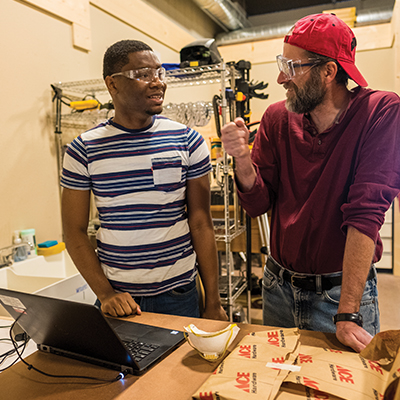 The Stew Makerspace
The Stew MakerspaceThe GEP team also wrote a grant for art supplies and activities to be distributed through the Tiger Packs Program, a community initiative addressing food insecurity among local youth. Recognizing that not every household has internet access at home, the partnership worked with the Drake Community Library and the Grinnell-Newburg School Foundation to provide Wi-Fi hotspots to make online learning easier.
At a moment of extreme social isolation, the projects were instrumental in providing connections and support to help minimize learning loss during the pandemic.
Fueled by the College, the Greater Poweshiek Community Foundation, and more than 20 community organizations, GEP brings together the resources of numerous organizations to help support children and families in Grinnell. “By bringing communities together, we are able to work collectively to create opportunities through transformative partnerships,” says Melissa Strovers, director of collective impact at the College.
It’s not just young students who benefit. College students and recent alumni gain useful experience as they build relationships, develop programming, write grants, and plan events. In summer 2022 alone, eight Grinnell College students served as AmeriCorps members working directly with kids at partner sites throughout Grinnell.
Working collectively with community partners and the school district makes a real impact: Reading skills in the Grinnell-Newburg school district have improved measurably since the program’s inception in 2015, and the partnership has been recognized with eight state and national awards.
Distinctive Physical Spaces Bring Together Diverse Groups.
The built environment has a profound impact on human experience and interaction, and both the town and the College sponsor distinctive spaces that offer informal opportunities for people from different backgrounds to gather and connect over shared interests.
The Stew Makerspace, jointly supported by the College’s Wilson Center and the Grinnell Area Arts Council, offers everything from button makers to laser cutters for creative projects. High school and College students get free access to “the Stew,” which is near campus on Broad Street. Community members can join for a fee.
Saints Rest is a downtown Grinnell coffee shop friendly to high school and College students, College faculty and staff, and Grinnell residents. In 2018, an article in The New York Times noted that “all paths seem to cross” at the much-loved hub. In the spring of 2020, owner Sam Cox rounded up caps and gowns and hosted an impromptu graduation photo booth so seniors graduating remotely because of the pandemic could have a real-life graduation experience and memento.
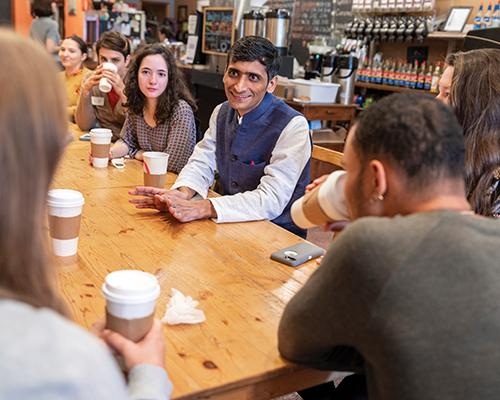 Shafiq R. Khan, a Grinnell College Innovator for Social Justice Prize winner, has coffee with students, staff, and faculty at Saints Rest in October 2019
Shafiq R. Khan, a Grinnell College Innovator for Social Justice Prize winner, has coffee with students, staff, and faculty at Saints Rest in October 2019The Pioneer Bookshop, downtown on Main Street, offers typical college bookstore fare like textbooks and College-branded attire — a must-visit for College students. But its inventory also includes children’s picture books, toys, and locally sourced items including honey, making it an inviting location for Grinnell residents as well. The bookstore donates a portion of December sales to Grinnell-Newburg school libraries. “We hope to make it a little easier for the librarian to obtain the most popular books that spark the interest of young readers,” says Cassie Wherry, manager of the bookshop.
In late 2022, Grinnell trustees approved construction of the core residential building (to be named Renfrow Hall; see Page 22) of the Civic Engagement Quad project to be located at the edge of campus at Sixth Avenue and Broad Street. “The project is a way for the College to be more intentional about connecting the physical campus with the downtown business district,” says Chavez- Silva, who notes that the project will not only include student housing, but also public green spaces and a civic innovation pavilion for use by all. Together with a new mixed-use apartment building planned for the same block by Merge Urban Development, restaurants and retailers will enjoy much more foot traffic downtown.
Mellon Research Identifies Opportunities for Connection Through Humanities.
With support from a Mellon Presidential Leadership grant, the College worked with a qualitative research company to understand how individuals in the College and community defined the humanities. The research helped identify ways that the campus and community could come together for events such as lectures, films, classes, workshops, and exhibitions with humanities themes. “Through these events, we learn more about the world we live in and how to live in harmony and understanding,” says Smith.
The grant funded more than just understanding; with the help of Mellon funds, campus organizations and community nonprofits received funding to support their own community-based projects.
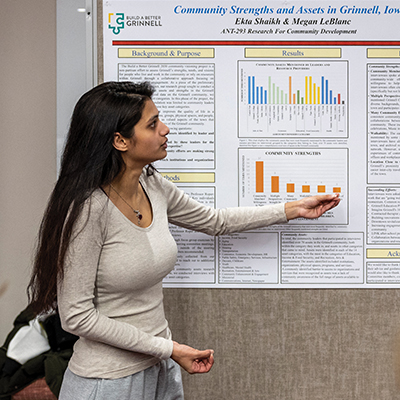 Build a Better Grinnell poster session in December 2022
Build a Better Grinnell poster session in December 2022Build a Better Grinnell Thinks Big About What’s Next.
In the spring of 2022, campus and community members started asking a big question: what would make Grinnell a stronger, more vibrant, more meaningfully connected community in the coming decade?
From that big question, Build a Better Grinnell 2030 was born. A collaboration among numerous organizations including the College, the multiyear project is now undertaking a communitywide assessment with broad participation from all parts of Grinnell. Based on its findings, contributors will map out a plan — and implement it. “This is an opportunity to identify and prioritize community needs and guide the community going forward,” Strovers says.
Grinnellians aren’t the only ones who see promise in the project. In November, Build a Better Grinnell received a $200,000 U.S. Department of Agriculture Rural Placemaking Innovation Challenge Grant that will support Build a Better Grinnell’s efforts.
The Ignite Program Catalyzes the Enthusiasm of Young Learners.
Twice a year, about 100 preschool-through-sixth-grade students head to campus for a day to learn from Grinnell College students. They crack codes, study the planets, or become amateur chocolatiers. The goal? To expose young students to a meaningful educational experience and get them comfortable on a college campus.
While the kids love it, the College’s Ignite teacher scholars might love it even more; surveys found that 100 percent of the teacher-scholars would recommend the experience to a friend — and many end up teaching at the event all four years at Grinnell.
Experiments Support “Good Neighbor” Vibes.
Creating meaningful connection points between campus and community doesn’t always require huge budgets or vast planning committees — that’s why Chavez-Silva and her team frequently test out modest, one-time events and other initiatives to inject a little more joy into everyday life. “The great thing about a small college and a small town is that if you want something, you can almost always help to make it happen,” she says. Here are just a few examples:
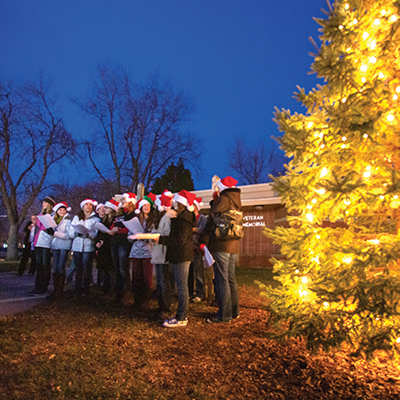 downtown holiday sing-along
downtown holiday sing-alongFor a late November “Jingle Bell Holiday” event, the College rented a horse and carriage to bring students from the Joe Rosenfield Center to downtown Grinnell, where they could warm up with a free beverage from Saints Rest. Some 350 students participated in the event.
To support local organizations and events — a local scout troop or an annual kite festival, for example — the College offers frequent donations such as gift certificates or items from the bookstore. “We want to be good neighbors,” says Chavez-Silva. “Our philosophy is basically to say yes to almost everybody if we can.”
The College also offers a more formal community mini-grant program where a committee of faculty and staff review grants to local area organizations seeking to expand programming or build capacity.
As part of the Volunteer Initiative Program, Grinnell College employees who volunteer their time at any nonprofit organization can fill out a simple form and designate $100 to be donated by the College to that organization. “We have volunteer firefighters, people on the board of a local historical museum, and people who spend their time volunteering at an animal shelter,” says Chavez-Silva. “It’s amazing to read the stories about the places that people spend their time.”
In some ways, these efforts are just the tip of the iceberg. As President Harris looks ahead, she’s thrilled about the potential for the town and the College to work together in the future. “I think there’s been a lot of appreciation for each other for many years, and in more recent years, the pandemic made us really understand what it meant to stand together and care for this community,” she says. “What gives me hope is how much we really value each other.”
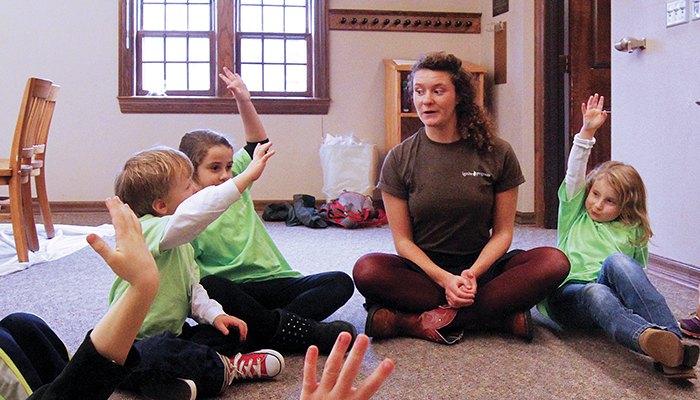 Ignite program STEM event
Ignite program STEM event
